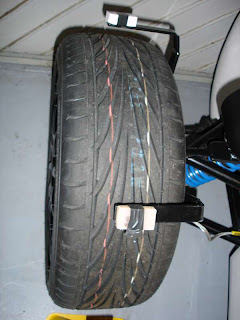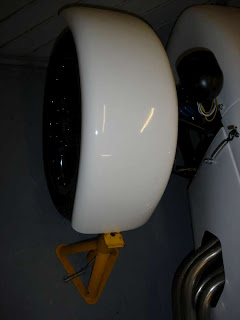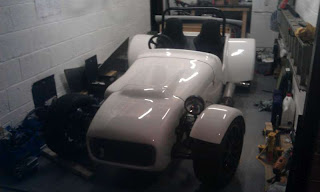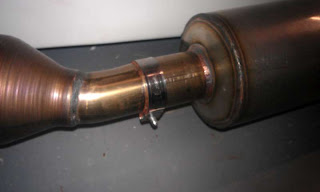After the bonnet the job I was least looking forward to was fitting the cycle wings. It did indeed turn out to be quite involved.
First off I needed to clear the threads in the front uprights - these were rusty and also had some paint in them. I hadn't realised when renewing the uprights that these threaded holes would be needed. A second hand 8mm tap from a local tool shop did the job easily.
Spacer tubes need to be cut to mount the cycle wing vertical arms the correct distance from the tyres. This is a bit of trial and error and I found it easiest to use washers to calculate the length prior to cutting the tubes.
With the stays mounted in the correct position I could start to fit the cycle wings themselves. They don't just bolt on unfortunately. The horizontal arms of the stays need to be bent up into the curvature of the cycle wings. To work out how far to bend them I tried spacers of different thickness. A couple of pencil rubbers turned out to be perfect for the job.
Then the stays were bent in the vice, ensuring that the upper part remained parallel with the tyre. Due to the bending of the stays some of the powder coating flaked off. Some Hammerite was applied to prevent rusting.
A length of bicycle inner tube (700c x 23) was pulled over the horizontal arms to protect the fibreglass from the metal edges. Holes were drilled in the cycle wings and stays and then dome head bolts used to secure them together.
19mm holes were drilled to accommodate the LED side repeaters. I had to be careful here as it is quite close to the edge and I didn't want to split the cycle wing. The repeaters are mounted by inserting the rubber collar into the hole and then pushing the light through, making sure the 'TOP" marking was uppermost. Due to the curvature of the cycle wing shoulder the rubber did not want to sit fully flat with the (curved) surface. A little persuasion from Mr Super Glue did the trick.
Finally, the wiring for the side repeaters was extended to reach the inside of the car. This was cabled tied to the cycle wings stays and under the cycle wings cable tie mounts were attached using Grip Fill. Before fitting the side repeaters I tested them on the car battery. They are reassuringly bright. One oddity is that the black lead is not negative, but positive! White is negative.
In the end I am quite pleased with result, but the cycle wings are quite a lot of effort from start to finish.
First off I needed to clear the threads in the front uprights - these were rusty and also had some paint in them. I hadn't realised when renewing the uprights that these threaded holes would be needed. A second hand 8mm tap from a local tool shop did the job easily.
Spacer tubes need to be cut to mount the cycle wing vertical arms the correct distance from the tyres. This is a bit of trial and error and I found it easiest to use washers to calculate the length prior to cutting the tubes.
With the stays mounted in the correct position I could start to fit the cycle wings themselves. They don't just bolt on unfortunately. The horizontal arms of the stays need to be bent up into the curvature of the cycle wings. To work out how far to bend them I tried spacers of different thickness. A couple of pencil rubbers turned out to be perfect for the job.
Then the stays were bent in the vice, ensuring that the upper part remained parallel with the tyre. Due to the bending of the stays some of the powder coating flaked off. Some Hammerite was applied to prevent rusting.
The cycle wings were then trial fitted using an axle stand as a height reference. The current IVA manual states that the cycle wings must extend at least 50 degrees to the rear and 30 degrees to the front. The rear was nearly 90 degrees so that was okay. The front was harder to measure. In the end the geometry of the wheel came to the rescue. There are 12 spokes. 360 degrees divided by 12 equals 30 degrees per spoke. With one spoke vertical I could easily determine that I had about 45 degrees coverage to the front.
A length of bicycle inner tube (700c x 23) was pulled over the horizontal arms to protect the fibreglass from the metal edges. Holes were drilled in the cycle wings and stays and then dome head bolts used to secure them together.
19mm holes were drilled to accommodate the LED side repeaters. I had to be careful here as it is quite close to the edge and I didn't want to split the cycle wing. The repeaters are mounted by inserting the rubber collar into the hole and then pushing the light through, making sure the 'TOP" marking was uppermost. Due to the curvature of the cycle wing shoulder the rubber did not want to sit fully flat with the (curved) surface. A little persuasion from Mr Super Glue did the trick.
Finally, the wiring for the side repeaters was extended to reach the inside of the car. This was cabled tied to the cycle wings stays and under the cycle wings cable tie mounts were attached using Grip Fill. Before fitting the side repeaters I tested them on the car battery. They are reassuringly bright. One oddity is that the black lead is not negative, but positive! White is negative.
In the end I am quite pleased with result, but the cycle wings are quite a lot of effort from start to finish.






